Chihuahua (dog)
The Chihuahua (/tʃɪˈwɑːwə, -wɑː, -ˈwaʊ.ə/ (![]()
| Chihuahua | |||||||||||||||||||||||||||||
|---|---|---|---|---|---|---|---|---|---|---|---|---|---|---|---|---|---|---|---|---|---|---|---|---|---|---|---|---|---|
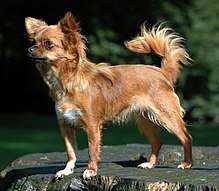 A purebred Chihuahua showing the classic features of the breed | |||||||||||||||||||||||||||||
| Other names | Chihuahua | ||||||||||||||||||||||||||||
| Common nicknames | Chi, Chi-chi, Hua-hua | ||||||||||||||||||||||||||||
| Origin | Mexico | ||||||||||||||||||||||||||||
| |||||||||||||||||||||||||||||
| |||||||||||||||||||||||||||||
| Dog (domestic dog) | |||||||||||||||||||||||||||||
History
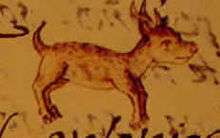

The Chihuahua's history is convoluted, and many theories surround the origin of the breed. Both folklore and archaeological finds show that the breed has origins in Mexico. The most common theory is that Chihuahua is descended from the Techichi, a companion dog favored by the Toltec civilization in Mexico.[2] No records of the Techichi are available before the 9th century, although dog pots from Colima, Mexico, buried as part of the western Mexico shaft tomb tradition, which date back to 300 BC, are thought to depict Techichis.[3]
The earlier ancestors probably had been present before the Mayas as dogs approximating the Chihuahua are found in materials from the Great Pyramid of Cholula, antedating 1530 and in the ruins of Chichen Itza on the Yucatán Peninsula.[2] However, a genetic study indicated that there was less than 2 percent pre-European mitochondrial DNA in modern Chihuahuas due to admixture with the European dogs.[4]
In a 1520 letter, Hernan Cortés wrote that the Aztecs raised and sold little dogs as food.[5] Colonial records refer to small, nearly hairless dogs at the beginning of the 19th century, one of which claims 16th-century Conquistadores found them plentiful in the region later known as Chihuahua.[6] Small dogs such as Chihuahuas were also used as living heating pads during illness or injury. Some believe this practice is where the idea of pain being transferred to animals from humans originated, which gave way to rituals such as burning the deceased with live dogs, such as the Techichi, to exonerate the deceased human's sins.[7] Chihuahuas as we know them today remained a rarity until the early 20th century; the American Kennel Club (AKC) did not register a Chihuahua until 1904.[8]
Appearance
Chihuahuas are the smallest breed recognised by some kennel clubs.[9]
There are two varieties of Chihuahua recognised by the AKC and the UK Kennel Club – the Smooth Coat (smooth-haired) and the Long Coat (long-haired). The UK Kennel Club considers the two to be distinct breeds; mating between the two are not eligible for KC registration. The AKC considers Long and Smooth coated chihuahuas to be the same breed.[10] Typically, the breed standard for both the Long and Smooth coat Chihuahuas will be identical except for the description of the coat.[11]
Both the Smooth and the Long Coats have their special attractions and are equally easy to keep clean and well-groomed.[12] The term smooth coat does not mean that the hair is necessarily smooth, as the hair can range from having a velvet touch to a whiskery feel. Longhaired Chihuahuas are actually smoother to the touch, having soft, fine guard hairs and a downy undercoat, which gives them their fluffy appearance. Unlike many longhaired breeds, longhaired Chihuahuas require no trimming and minimal grooming. Contrary to popular belief, the longhaired breed also typically sheds less than its shorthaired counterparts. Up to three or more years may be needed before a full longhaired coat develops.
Current breed standards defined by registries such as the AKC specify an "apple-head" or "apple-dome" skull conformation.[13] Chihuahuas have large, round eyes and large, erect ears, set in a high, dramatically rounded skull.[9] The stop is well defined, forming a near 90 degree angle where the muzzle meets the skull.[10]
Breed standards for this dog do not generally specify a height; only a weight and a description of their overall proportions. Generally, the height ranges between 6 and 9 in (15 and 23 cm);[9] however, some dogs grow as tall as 30 to 38 cm (12 to 15 in).[14] Both British and American breed standards state that a Chihuahua must not weigh more than 5.9 lb (2.7 kg) for conformation.[9] However, the British standard also states that a weight of 4–6 lb (1.8–2.7 kg) is preferred. A clause stating. "if two dogs are equally good in type, the more diminutive one is preferred" was removed in 2009.[15] The Fédération Cynologique Internationale standard calls for dogs ideally between 1.5 and 3.0 kg (3.3 and 6.6 lb), although smaller ones are acceptable in the show ring.[16]
Pet Chihuahuas (that is, those bred or purchased as companions rather than show dogs) often range above these weights, even above 10 lb if they have large bone structures or are allowed to become overweight.[9] This does not mean that they are not purebred Chihuahuas; they just do not meet the requirements to enter a conformation show. Oversized Chihuahuas are seen in some of the best, and worst, bloodlines. Chihuahuas do not breed true for size, and puppies from the same litter can mature in drastically different sizes from one another. Also, larger breeding females are less likely to experience dystocia (obstructed labour). Many breeders try to breed Chihuahuas as small as possible, because those marketed as "teacup" or "tiny teacup" command higher prices.[17]
Chihuahuas occur in virtually any color combination, from solid to marked or splashed,[18] allowing for colors from solid black to solid white, spotted, sabled, or a variety of other colors and patterns. Colors and patterns can combine and affect each other, resulting in a very high degree of variation. Common colors are fawn, red, cream, chocolate, brown, mixed, white, and black. No color or pattern is considered more valuable than another.
The merle coat pattern, which appears mottled, is not traditionally considered part of the breed standard. In May 2007, The Kennel Club decided not to register puppies with this coloration due to the health risks associated with the responsible gene, and in December of that year, formally amended its breed standard to disqualify merle dogs.[19] The Fédération Cynologique Internationale, which represents the major kennel clubs of 84 countries, also disqualified merle.[16] Other countries' kennel clubs, including Canada, Australia, New Zealand, and Germany, have also disqualified merle. However, in May 2008, the Chihuahua Club of America voted that merles would not be disqualified in the United States, and would be fully registrable and able to compete in AKC events. Opponents of merle recognition suspect the coloration came about by modern crossbreeding with other dogs and not by natural genetic drift.[20]
Apple head vs. Deer head Chihuahuas
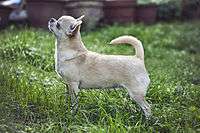
Dogs of any coat type may be identified as either "apple head" or "deer head" Chihuahuas. Apple heads have rounded heads, close-set eyes, and relatively short ears and legs. Deer heads have flat-topped heads, more widely set eyes, larger ears, and longer, more slender legs. Deer heads were the breed standard conformation in the mid-20th century, but current breed standards defined by registries such as the AKC specify the apple-head conformation.[13]
The Apple Head Chihuahua is known for having a round/apple-shaped head and a definite "stop" whereas a Deer Head Chihuahua "may" have a flatter head, thinner skull, but is unlikely to have a "stop" and will probably have a much longer nose. Their physical body shape is largely the same, except the Deer Head Chihuahua is known to have longer legs than other Chihuahuas.[21] The Deer Head Chihuahua tends to be larger in weight, where an Apple Head is more likely to keep their weight under ten pounds.
Apple Head Chihuahuas are longer than they are tall and have shorter necks.[22] Deer Head Chihuahuas have longer ears than Apple Heads and their head also has a slope-shaped form. Both Apple Head and Deer Head can have short hair or long hair. They also both come in various different colors such as brown, black, tan, or white. Chihuahuas can show traits from both Apple Head and Deer Head.[23]
"Deer Head Chihuahuas tend to have better health than Apple Heads, due to their longer noses". There is no scientific evidence that Apple Heads have a higher risk of getting respiratory issues, due to having a smaller airway. Deer Headed Chihuahuas are not allowed in the AKC due to not meeting the standards that Apple Heads do. Deer Head Chihuahuas are not allowed because they have a longer jaw line and a slope that connects their muzzle and head, creating a 45 degree angle instead of a 90 degree angle like the Apple Head.[24] Apple Heads are allowed in the AKC and meet the requirements due to having a smaller weight, having a rounder head, and also having a 90 degree angle formed by the muzzle to the forehead.[10]
Temperament
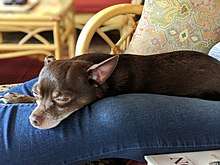
How a Chihuahua behaves depends on the genetic temperament of their parents and grandparents.[25] Their small size makes them delicate and vulnerable to injuries and attacks from larger animals. Like all dogs, they benefit from appropriate socialization and training.[26] Chihuahuas tend to learn better when being rewarded positive reinforcement, such as a treat or praise. With the proper training a Chihuahua needs, this dog can be extremely intelligent. The way a dog is trained will influence its behavior.[27]
Chihuahuas can be easily frightened or provoked to attack, so are generally unsuitable for homes with small children.[28] The breed tends to be fiercely loyal to one particular person and in some cases may become overprotective of the person, especially around other people or animals,[28] and tend to have a "clannish" nature, often preferring the companionship of other Chihuahuas or Chihuahua mixes over other dogs.[29] These traits generally make them unsuitable for households with children who are not patient and calm.[18]
Because Chihuahuas get cold easily they tend to love their dens and will often burrow themselves in pillows, clothes hampers, and blankets. They are often found under the covers or at the bottom of the bed, deep in the dark and safety of what they perceive as their den. Chihuahuas also enjoy time in sunlight.[30] Chihuahuas sometimes act like cats and climb up to the highest point on a couch, usually on top of the pillows, and curl up into a ball. Chihuahuas have their own type of personality. They tend to be alert. Chihuahuas typically do not show fear; even though they are a smaller breed, they do not view their size as a disadvantage. [31]
Health
.jpg)
This breed requires expert veterinary attention in areas such as birthing and dental care. Dental care is a must for these small dogs, whose jaw size makes for weaker teeth. Although daily brushing provides the best preventive measure, feeding a dental diet or using dental chews for dogs is an effective approach pet owners can take to help prevent and control accumulation of plaque and tartar to avoid consequences of severe periodontal disease.[32] The best physical characteristics of dog food to contribute to cleaning a dog's teeth would be food that is large and dense, so more time is spent chewing, which leads to the surface of the teeth being cleaned.
Chihuahuas, and other toy breeds, can be affected by hydrocephalus.[33] Chihuahua puppies with hydrocephalus have an abnormally large head, are lethargic, and do not grow at the same pace as their siblings. A true case of hydrocephalus can be diagnosed by a veterinarian, though the prognosis is grim.
Apple head Chihuahuas can have moleras, or a soft spot in their skulls, and they are the only breed of dog to be born with an incomplete skull. This is not a defect; it is a normal adaptation facilitating the passage through the birth canal and growth and development of the domed type of forehead. The molera is predominant in the apple heads and is present in nearly all Chihuahua puppies. The molera fills in with age, but great care needs to be taken during the first six months until the skull is fully formed. Some moleras do not close completely and require extra care to prevent injury.[34]
Chihuahua puppies can be at risk for hypoglycemia (low blood sugar). Signs of hypoglycemia include lethargy, sleepiness, uncoordinated walking, unfocused eyes, spasms of the neck muscles or head pulling back or to the side, fainting, and seizures. Hypoglycemia can be avoided with adequate nutrition and frequent feedings, especially for Chihuahuas that are younger, smaller, or leaner. Chihuahua owners should have a simple-sugar supplement on hand to use in emergencies, such as Nutri-Cal or corn syrup. These supplements can be rubbed on the gums and roof of the mouth to rapidly raise the blood sugar level.
However, as with any dog, owners should take care not to overfeed their Chihuahua, since obesity can result in increased rates of joint injuries, tracheal collapse, chronic bronchitis, and shortened lifespan.
As in other breeds with large protruding eyes, Chihuahuas are prone to eye infections and eye injury. The eyes may water in response to dry air, dust, or airborne allergens.
Collapsed trachea is a health concern characteristic of the Chihuahua breed.[35]
Chihuahuas may tremble or shiver when stressed, excited, or cold. These dogs, especially the short coat variety, are less tolerant of cold than larger breeds, and require a sweater/coat and/or boots in cold weather. They seek warmth in sunshine, under blankets, or on furniture, or human laps.
Some Chihuahuas may present separation anxiety as a result of being so close and loyal to their owners. This is a fairly common cause behind any pacing, excessive salivating, destructive chewing, or barking, howling, or whining in dogs. Many treatments and tips can help prevent separation anxiety in dogs.
The lifespan for a Chihuahua is usually between 12 and 20 years.[36]
Chihuahuas are also known for luxating patella, a genetic condition that can occur in all dogs. In some dogs, the ridges forming the patellar groove are not shaped correctly and a shallow groove is created, causing the patella to luxate or slip out of place, sideways. The knee cap sliding across the bony ridges of the femur can cause some pain. The affected chihuahua will hold its leg flexed, and foot off the ground until the quadriceps muscle relaxes and lengthens, after which the animal feels no discomfort and continues with activity.
Chihuahuas are also prone to some heart-related disorders, such as heart murmurs and pulmonic stenosis, a condition in which the blood outflow from the heart's right ventricle is obstructed at the pulmonic valve.
Chihuahua crossbreeds
Apart from different types of Chihuahuas, breeders across the world started crossbreeding Chihuahuas with other dog breeds in order to create breeds of mixed traits. The result of crossbreeding Chihuahuas with other dog breeds such as Pomeranian dogs, Pembroke Welsh Corgis, Boston Terriers, Pugs and so on, usually ends up in a dog breed of a Chihuahua's body size and the other parent breed's coat color and fur traits. These are the most common Chihuahua crossbreeds:
- Chihuahua and Yorkshire Terrier - also known as the Chorkie
- Chihuahua and Pug – also called the Chug[37]
- Chihuahua and Bichon Frise – also called the Chi Chon
- Chihuahua and Boston Terrier – also known as the Boston Huahua
- Chihuahua and Pekingese – also known as the Cheek
- Chihuahua and Cavalier King Charles Spaniel – also known as the Chilier [38]
- Chihuahua and Jack Russell – also called the Jack Huahua
- Chihuahua and Pomeranian – also called the Pomchi
- Chihuahua and Pembroke Welsh Corgi – also called the Chigi
- Chihuahua and Poodle – also known as Chipoo
- Chihuahua and Dachshund – also called the Chiweenie
- Chihuahua and MinPin (Miniature Pinscher) – also called the Chipin
- Chihuahua and Pitbull/Terrier - also called a Chibull or Pithuahua
Poodles and Bichon Frise dog breeds are often used in crossbreeding because of their hypoallergenic fur. This way, the developed crossbreed might inherit entirely or partly this allergy-friendly trait, which makes it more suitable for individuals that suffer from pet allergies.
Gallery
- A smooth coat Chihuahua
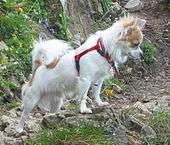 A long coat white parti-color Chihuahua
A long coat white parti-color Chihuahua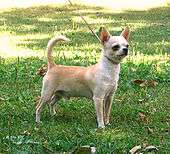 A smooth coat Chihuahua
A smooth coat Chihuahua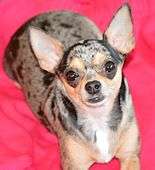 A shorthaired blue merle Chihuahua
A shorthaired blue merle Chihuahua- A longhaired Chihuahua
 Excellent example of a smooth coat Chihuahua
Excellent example of a smooth coat Chihuahua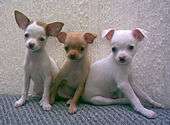 Chihuahua puppies
Chihuahua puppies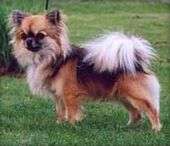 A longhaired brown Chihuahua with dark saddle
A longhaired brown Chihuahua with dark saddle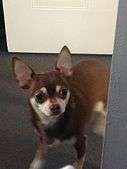 A chocolate and tan shorthaired Chihuahua portrait showing the characteristic traits of the breed
A chocolate and tan shorthaired Chihuahua portrait showing the characteristic traits of the breed A sable longhaired Chihuahua portrait
A sable longhaired Chihuahua portrait- A chocolate long coat Chihuahua
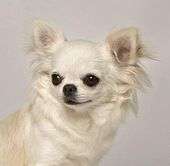 A cream-coloured long coat Chihuahua
A cream-coloured long coat Chihuahua Soft Nosed Chihuahua
Soft Nosed Chihuahua A white Chihuahua on the beach
A white Chihuahua on the beach Shorthaired chocolate-tri-color Chihuahua
Shorthaired chocolate-tri-color Chihuahua Adult shorthaired Chihuahua
Adult shorthaired Chihuahua.jpg) Longhaired black & white Chihuahua
Longhaired black & white Chihuahua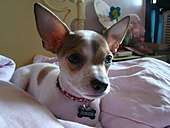
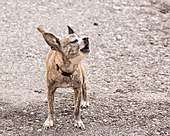

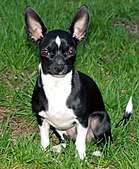
See also
- Companion dog
- Companion Dog Group
- Dogs in Mesoamerica
- Toy Group
References
| Wikimedia Commons has media related to: |
- Wells, John (April 3, 2008). Longman Pronunciation Dictionary (3rd ed.). Pearson Longman. ISBN 978-1-4058-8118-0.
- "Chihuahua History". American Kennel Club. Retrieved April 3, 2011.
- "LostWorlds.org – Were Creek Indians from West Mexico?". February 27, 2011. Retrieved February 15, 2012.
- Ni Leathlobhair; et al. (July 6, 2018). "The evolutionary history of dogs in the Americas". Science. 361 (6397): 81–85. doi:10.1126/science.aao4776. PMID 29976825.
- "Hernan Cortés: from Second Letter to Charles V, 1520". Fordham University. Retrieved March 25, 2014.
- Pedro Baptista Pino y Juan Lopez Cancelada, Exposición sucinta y sencilla de la Provincia del Nuevo México y otros escritos. Ed. Jesus Paniagua Perez. Valladolid: Junta de Castilla / León: Universidad de León, 2007, p. 244: "even in the desert the tiny dogs could be found, hunting rats, mice, and lizards. " The footnote that follows alludes to starving Conquistadores reportedly hunting and stewing the dogs (Universidad Veracruzana, Arquivo Viejo, XXVI.2711).
- Coile, C. (2000). The Chihuahua Handbook. Hauppauge, NY: Barron’s Educational Series, p. 3: "Small dogs have been used as living hot-water bottles throughout the world for centuries. Placing a warm dog onto an aching body part can be soothing, and it may be where the idea arose that the pain was being transferred from the person to the dog."
- Coile, C. (2013). Chihuahuas: Everything about purchase, care, nutrition, behavior, and training. Hauppauge, NY: Barron’s Educational Series, p. 7: "Only in 1904 did the American Kennel Club (AKC) register its first Chihuahua; a total of five were registered that year.”
- Charlotte Wilcox (April 1, 1999). "Quick Facts". The Chihuahua. Capstone. pp. 4–5. ISBN 978-0-7368-0158-4. Retrieved March 1, 2013.
- "Official Standard of the Chihuahua" (PDF). Retrieved November 12, 2019.
- "CCA-Teacup Statement". Chihuahuaclubofamerica.com. May 30, 2009. Retrieved January 19, 2011.
- "The Kennel Club". Retrieved October 5, 2015.
- Walker, Joan Hustace (2006). The Everything Chihuahua Book: A Complete Guide to Raising, Training, And Caring for Your Chihuahua. Adams Media. pp. 16–18. ISBN 9781440523687. Retrieved June 15, 2019.
- "Chihuahua Appearance". planetchihuahua.com. May 7, 2017. Retrieved September 7, 2018.
- "The Kennel Club". thekennelclub.org.uk.
- "Chihuahua standard" (PDF). Fédération Cynologique Internationale. July 28, 2009. Retrieved October 25, 2011.
- Segovia, Stacey Smith (March 21, 2004). "Runt of the litter". The Leaf Chronicle. ProQuest 441596979.
- American Kennel Club Chihuahua page, retrieved on July 29, 2007.
- "Kennel Club breed standard". Thekennelclub.org.uk. May 15, 2006. Archived from the original on January 3, 2009. Retrieved August 14, 2009.
- "Chihuahua Breed Standards | Chihuahuas as Pets". Retrieved December 19, 2018.
- "7 Types of Chihuahuas You'll Love in 2019 (Guide + Tips)". puppywire.com. Retrieved November 12, 2019.
- "Deer Head Chihuahua vs. Apple Head Chihuahua". Animalso. Retrieved November 12, 2019.
- "Deer Head vs Apple Head Chihuahua: What's the Difference?". Retrieved November 12, 2019.
- "Deer Head Chihuahua vs. Apple Head Chihuahua". Animalso. Retrieved November 12, 2019.
- "Chihuahuas: What's Good and Bad About Chihuahua Dogs". Retrieved July 10, 2016.
- Burke, Kelly. "Chihuahua Obedience Training". Chihuahua Traits. Archived from the original on November 16, 2015.
- "Chihuahua Dog Breed Information". Vetstreet. Retrieved November 12, 2019.
- The Chihuahua, Dog Owners Guide at canismajor.com.
- About Chihuahuas, British Chihuahua Club, retrieved on July 29, 2007.
- Coile, D. Caroline (2010). The Chihuahua handbook (2nd ed.). Hauppauge, N.Y.: Barron's Educational Series. p. 27. ISBN 978-0764143304.
- "Chihuahua Dog Breed Information". Vetstreet. Retrieved November 12, 2019.
- Logan, Ellen I. (2006), "Dietary Influences on Periodontal Health in Dogs and Cats", Veterinary Clinics of North America: Small Animal Practice, Elsivier Saunders, 36 (6): 1385–1401, doi:10.1016/j.cvsm.2006.09.002, PMID 17085242
- "Hydrocephalus". Genetic Welfare Problems of Companion Animals. ufaw.org.uk: Universities Federation for Animal Welfare. Archived from the original on April 10, 2013. Retrieved February 10, 2015.
- "Molera Statement". Archived from the original on April 3, 2008. Retrieved September 5, 2010.CS1 maint: BOT: original-url status unknown (link)
- "tracheal collapse in chihuahuas: a serious chihuahua respiratory problem". famous chihuahua.
- "Chihuahua". Vetstreet.
- "Chug dog". Chug Dog – Ultimate Guide To The Chihuahua Pug Mix. barkingroyalty.com: Barking Royalty.
- "Chilier Dog Breed Info (Chihuahua Cavalier King Charles Spaniel Mix)". The Dogs Journal.